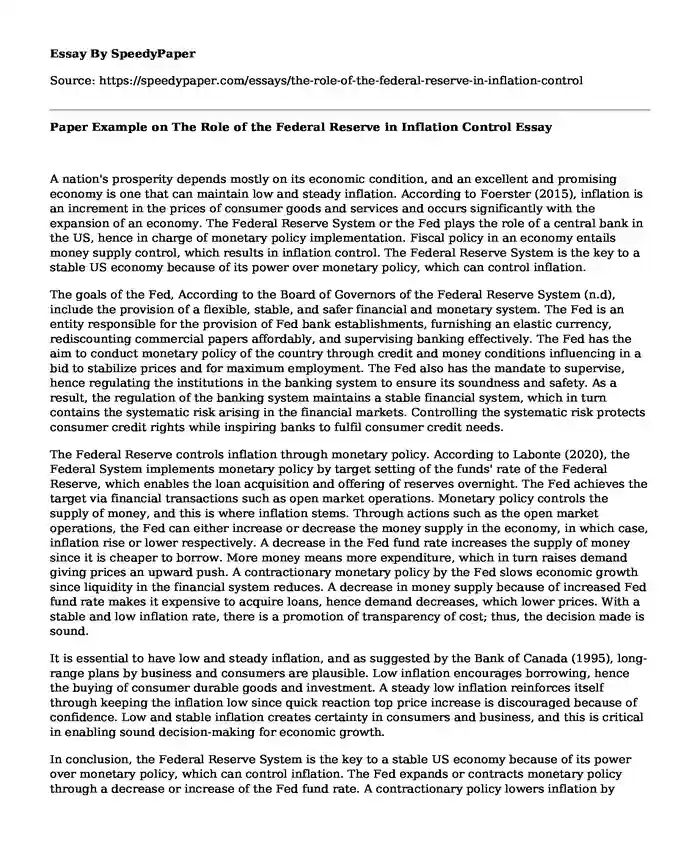
| Type of paper: | Essay |
| Categories: | Policy Inflation Government Financial management |
| Pages: | 3 |
| Wordcount: | 659 words |
A nation's prosperity depends mostly on its economic condition, and an excellent and promising economy is one that can maintain low and steady inflation. According to Foerster (2015), inflation is an increment in the prices of consumer goods and services and occurs significantly with the expansion of an economy. The Federal Reserve System or the Fed plays the role of a central bank in the US, hence in charge of monetary policy implementation. Fiscal policy in an economy entails money supply control, which results in inflation control. The Federal Reserve System is the key to a stable US economy because of its power over monetary policy, which can control inflation.
The goals of the Fed, According to the Board of Governors of the Federal Reserve System (n.d), include the provision of a flexible, stable, and safer financial and monetary system. The Fed is an entity responsible for the provision of Fed bank establishments, furnishing an elastic currency, rediscounting commercial papers affordably, and supervising banking effectively. The Fed has the aim to conduct monetary policy of the country through credit and money conditions influencing in a bid to stabilize prices and for maximum employment. The Fed also has the mandate to supervise, hence regulating the institutions in the banking system to ensure its soundness and safety. As a result, the regulation of the banking system maintains a stable financial system, which in turn contains the systematic risk arising in the financial markets. Controlling the systematic risk protects consumer credit rights while inspiring banks to fulfil consumer credit needs.
The Federal Reserve controls inflation through monetary policy. According to Labonte (2020), the Federal System implements monetary policy by target setting of the funds' rate of the Federal Reserve, which enables the loan acquisition and offering of reserves overnight. The Fed achieves the target via financial transactions such as open market operations. Monetary policy controls the supply of money, and this is where inflation stems. Through actions such as the open market operations, the Fed can either increase or decrease the money supply in the economy, in which case, inflation rise or lower respectively. A decrease in the Fed fund rate increases the supply of money since it is cheaper to borrow. More money means more expenditure, which in turn raises demand giving prices an upward push. A contractionary monetary policy by the Fed slows economic growth since liquidity in the financial system reduces. A decrease in money supply because of increased Fed fund rate makes it expensive to acquire loans, hence demand decreases, which lower prices. With a stable and low inflation rate, there is a promotion of transparency of cost; thus, the decision made is sound.
It is essential to have low and steady inflation, and as suggested by the Bank of Canada (1995), long-range plans by business and consumers are plausible. Low inflation encourages borrowing, hence the buying of consumer durable goods and investment. A steady low inflation reinforces itself through keeping the inflation low since quick reaction top price increase is discouraged because of confidence. Low and stable inflation creates certainty in consumers and business, and this is critical in enabling sound decision-making for economic growth.
In conclusion, the Federal Reserve System is the key to a stable US economy because of its power over monetary policy, which can control inflation. The Fed expands or contracts monetary policy through a decrease or increase of the Fed fund rate. A contractionary policy lowers inflation by discouraging borrowing hence limiting business and consumer expenditure. Low and stable inflation enhances certainty among firms and consumers; therefore, sound decision making and long term planning, which in turn stabilizes the economy.
References
Bank of Canada. (1995). Monetary policy report. https://www.bankofcanada.ca/wp-content/uploads/2010/04/mpr_apr_19951.pdf
Board of Governors of the Federal Reserve System. (n.d). Government performance and results Act planning document 1997-2002. https://www.federalreserve.gov/boarddocs/rptcongress/98frgpra.pdf
Foerster, S. (2015). Financial Management: Concepts and Applications. Pearson Education.
Labonte, M. (2020). Monetary policy and the Federal Reserve: Current policy and conditions. Congressional Research Service. https://fas.org/sgp/crs/misc/RL30354.pdf
Cite this page
Paper Example on The Role of the Federal Reserve in Inflation Control. (2023, Aug 08). Retrieved from https://speedypaper.net/essays/the-role-of-the-federal-reserve-in-inflation-control
Request Removal
If you are the original author of this essay and no longer wish to have it published on the SpeedyPaper website, please click below to request its removal:
- Essay Example on Minimizing Maternal Mortality by Over Three-Quarters
- Free Essay Sample: War on Drugs and Minority
- Free Essay Discussing the Role of Performance Evaluation in a Project Environment
- Essay Example on Amazon's Financial Trend
- Essay Sample on Implementation of an Action Plan
- Essay Sample on Conflicts with Being Raised By Parents Who Grew Up In Poverty
- Evaluation Essay Sample on Electronic Wallets
Popular categories




